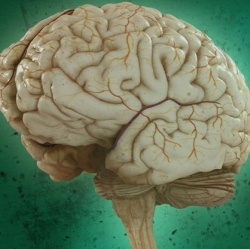
A cancer treatment that creates electric fields in the brain via a cap-like device can buy a few more months of life for patients with glioblastoma, the aggressive brain cancer that is essentially always fatal, physicians reported in JAMA, the Journal of the American Medical Association.
The 695 patients in the study had all undergone the standard treatment for glioblastoma: surgery, radiation, and the chemotherapy temozolomide. Among the 466 who continued to receive chemotherapy only, the average time before their brain tumors returned or spread was four months. That interlude lasted on average 6.7 months, however, in the 229 patients who also received the electric-field therapy, called Optune and manufactured by Novocure. In the chemo-only group, average survival was 16 months after entering the study, compared to 20.9 months for the chemo-plus-Optune patients.
Glioblastoma, which Sen. John McCain is battling, has a dismal prognosis. It strikes about 3 per 100,000 people in the U.S. every year. Some 85 percent of patients die within five years of when they’re diagnosed, 75 percent die within two years, and only half make it to 15 to 18 months. Patients and physicians are desperate for any glimmer of hope. In the last decade, there have been two dozen clinical trials of drugs for newly diagnosed glioblastoma. Zero found an improvement in survival. The last thing that was found to boost survival (by about two months) was the chemotherapy temozolimide, in 2005.
“The data are robust,” said Dr. Adilia Hormigo, director of neuro-oncology at Mount Sinai Health System in New York City, who was not involved in the study but is leading one that combines Optune with a cancer vaccine. Although the additional survival and “progression-free” period seem meager, she said, those averages conceal a fact important to patients: After two years, 43 percent of the Optune patients were alive, compared to 30 percent of the chemo-only patients. After five years, those rates were 13 percent for Optune and 5 percent for chemo-only patients.
“Is that great?” asked Dr. Roger Stupp of Northwestern University Feinberg School of Medicine, who helped design and led the JAMA study. “No, that’s the disappointing part. But it’s a 37 percent reduction in the risk of death [at two years], and the first thing we’ve had since 2004 [when the glioblastoma chemotherapy temozolomide was introduced] that improves survival.”
The Optune device, which costs about $21,000 a month, caused some skin irritation but otherwise has no serious side effects. It works by interfering with cell division; in the brain, cancer cells are almost the only ones that divide.
“This doesn’t mean we should declare victory” against glioblastoma, Stupp said. “But it’s one step toward improving patients’ quality of life and length of life.”
